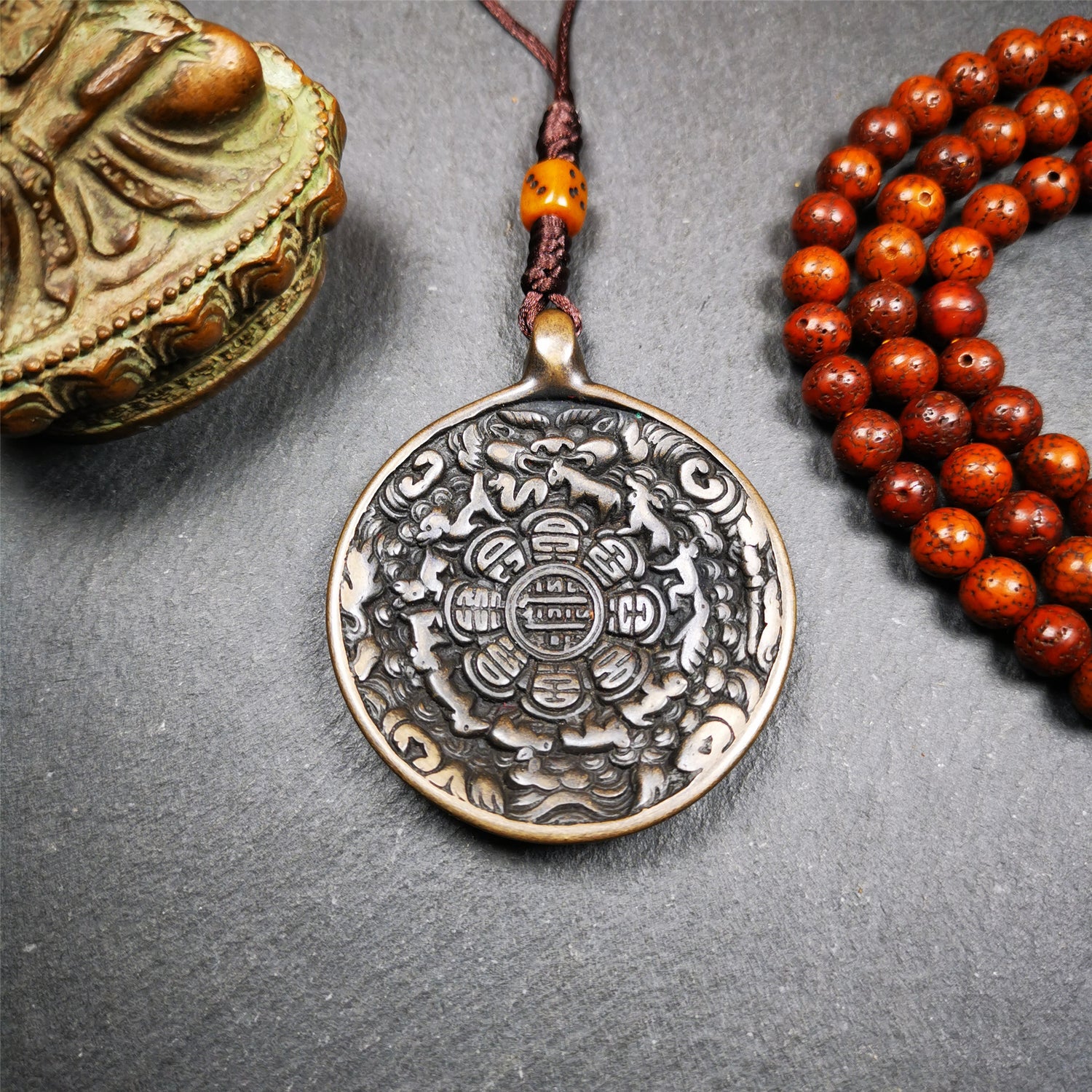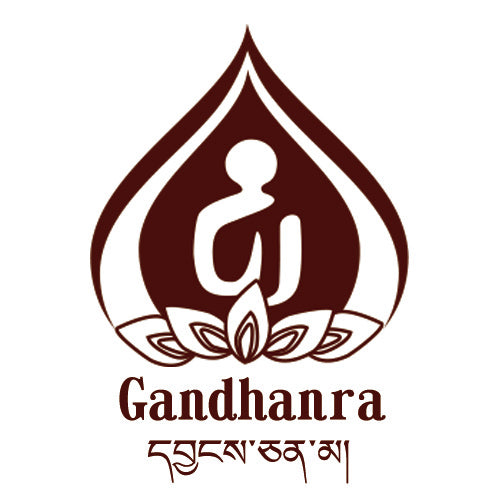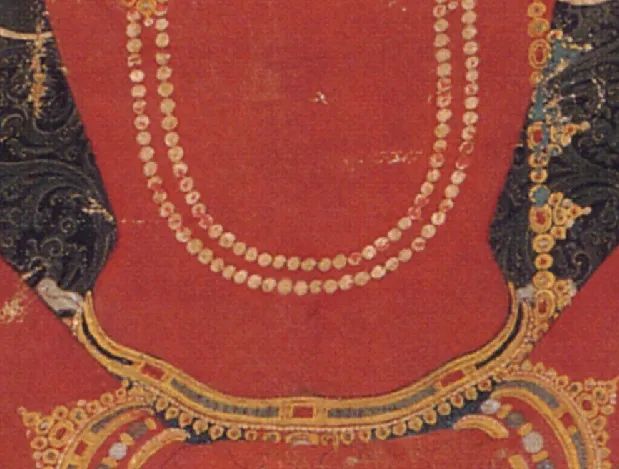
"The Gauge of Marey's Apparatus" 19th century, Los Angeles Group Art Museum
Create a blood sea and meat forest using glutinous rice cake for offering,
Where gods and demons gather under this red sky,
No longer will they disturb the myriad beings.

"Amitabha Altar City", 13th century, Museum of Fine Arts, Boston
Inheriting the painting tradition of the Nivarl region
"Red and yellow are in a teacher-student relationship"
(དམར་སེར་ཚོན་ནི་ཆོས་བརྒྱུད་དབྱིངས་)
When using the combination of red and yellow in the artwork
It can highlight the sacred relationship of transmitting teachings.

Local
Amitabha Buddha in the Pure Land of the Western Paradise
His body is red
The color of a clean and radiant flame
སྐག་/རྒྱ་ཚོས་ (dark red or crimson)
This Buddha shines like the sun and possesses an abundance of nectar
Also translated as Buddha of Infinite Light and Buddha of Infinite Life.

"The Three Hidden Longevity Figures", 18th century, Hahn Cultural Foundation
The radiant body of Amitayus Buddha is a bright crimson color.

"Suddhodana, the Venerable," 16th century, Rubin Museum.
Venerable Suphanto (Mi-phyed-pa)(མི་ཕྱེད་པ་)
Holding a stupa symbolizing enlightenment in his hands
In front of him is a branch of red coral offered by the dragon race
Red coral symbolizes the subduing of ghosts and spirits
It is said that coral is formed from the blood of the dragon race

Local: Red coral branch

Local:Valet (Merchant)
Attire in red clothing and turban, they are considered as Central Asian attendants of merchant status.
The golden vessel in their hands contains the nectar of the snow-capped mountains.
They are responsible for transporting offerings from all realms to the revered one.
In some image materials, they are accompanied by camels.

"Portrait of the Buddha Mother", 15th Century, Rubin Museum
"Huaiye" not only refers to career and livelihood, but also can lead to the ultimate state of bliss
The mother of this empty walking conqueror of the three realms
Manifests as a blood red body (ཤ་དམར་), displaying "Huaiye"
*Blood red is also known as flesh color (མི་ཤ་ཁ་)

Local
The central figure in the Bodhisattva's crown is the red-bodied Amitabha Buddha.

"The Great Mother and Father of All Beings", 18th century, Rubens Museum
Great Primordial Lord (Supreme God in South Asian tradition, Shiva)
In the context of Buddhism, one of the incarnations of Avalokiteshvara Bodhisattva
His consort is the Primordial Snow Mountain Goddess
Great Primordial Lord holds a significant position in the "Revealed Treasure Tradition"
In Tibetan, he is known as the "Blood Red Primordial Master"
(མཚལ་ཁ་གཏེར་བདག་)

Local: Crescent Moon Ornament
The core symbol of Shiva is the trident, also known as the trishul.

Local: Blood-red genitals
The worship of Shiva's Linga (लिङ्गं) is a form of devotion that does not involve the use of idols (such as the phallus symbol of Shiva).
It is a way to praise Shiva's creative and destructive powers without relying on physical representations.
དཀར་དམར་གཉིས་པོ་ཚོན་གྱི་མེ་ཏོག་ཡིན།
མཛེས་པར་འདོད་ན་དེ་ཡི་ནང་ལ་ཡོད།
White and red are colors of fresh flowers
If you add beautiful colors, it will be white and red
(Tibetan art world proverb)
*White and red are a color relationship of husband and wife
It represents the union of skillful means and wisdom or tantric practice
མཚལ་དང་ལི་ཁྲི་ཚོན་གྱི་རྒྱལ་པོ་ཡིན།
མ་འགྱུར་བརྟན་པོར་བཞུགས་ནས་བརྗིད་ཆགས་མཛོད།
Crimson and orange are the kings of colors
Eternal and unchanging, showcasing dignity and career
(Tibetan art saying)
*Related to the previous description of yellow
The symbolic significance of red in depicting monks
ཤ་དམར་ཟི་ཧུན་སྟག་གཟིགས་གིས།
སྤུ་དང་ལྤགས་པའི་ཚོན་ལ་དབང་
(……)
བློ་ཁ་རྒྱ་ཚོས་བཅད་མདངས་ཅན།
ལྤགས་རློན་ཤ་དམར་ཁྲག་མཚོར་དབང།
Meat red, peach red
Tiger and leopard fur colors
Lung red, vermilion red
Wet skin and blood clot colors
- Dema Gexi Danzeng Pengcu
དེའུ་དམར་དགེ་བཤེས་བསྟན་འཛིན་ཕུན་ཚོགས་
(1672-?)
* Red and black paired create a dark realm(མུན་ནག་)
The bodies of animals and mortals symbolize impure and chaotic minds
The dominant red is seen as the "bandit" among colors, while the red that occupies the perception of individuals is the commanding color of the land (whether the use of red is a challenge for the painter). In indigenous culture, red symbolizes death and rebirth, it is a primal color full of sacrificial meaning. As the worldly fireworks gradually diminish, the gods will bring down the rain of rebirth, known as blood rain (ཁྲག་ཆར་). The wandering Zanshen (བཙན་) in the mortal world observes the fluctuating vitality of life; red excites him, as it reflects the cycle of life and death, "the only unchanging law in the universe".

"Geser King Biography Thangka" (group of pictures), 19th century, Sichuan Museum
Central praises the god for "eliminating illness and protecting health"
(ཡམ་ཤུད་དམར་པོ་)

Local: Praise God
Generally, the body color of the praised god is red, accompanied by red dogs, red horses, and red birds.
Red is considered the color of order in the local culture.
The red-bodied praised god carries out the task of maintaining order, while earthly rulers are called "Zampu."
In Tibetan color theory, the color red is generally referred to as "九" (༩) in Tibetan script. Similar to other colors, the color red is typically referred to as "Ma" (མ་) in Tibetan script. Using the Tibetan letter "Ma" as the base, light red, pink, peach, and dark red are respectively referred to as "my" (མྱ་), "myi" (མྱི་), "myo" (མྱོ་), and "mu" (མུ་).
In addition to symbolizing "power and order" in the preservation of native culture, Buddhism has structured this expression of order. For Buddhists, red is the passionate color of practicing meditation to achieve wisdom beyond order. It represents the color of success in one's practice, and is also the color of purity symbolizing the protective space of the guardians.
When red meets green, it becomes the "parrot color"(ནེ་ཙོའི་ཚོན་) of all wise men. The debate that follows philosophical contemplation is the method by which Buddhism tests the wisdom of practitioners, with the parrot symbolizing the debater and the translator. It is important to note that unlike the red-green combination, yellow symbolizes the fruit of the "oral transmission tradition", that is, the teachings of the Buddha.

"Southern Carolina", 18th century, Rubin Museum
 Local: red and green complement each other
Local: red and green complement each other

Partial: Red and Orangeish-Red

"Red Lotus Plant with Painted Flowers", 19th century, Rubin Museum
The "red thangka" (མཚལ་ཐང་) refers to a painting with a red background.
It is commonly used for deities of power and gurus in Tibetan Buddhism.
The practice became popular in the late 17th century in the Tibetan region.

Breaking obsession above the blood red ocean


